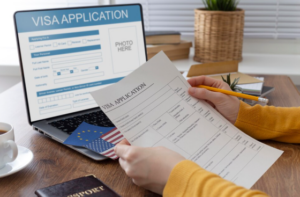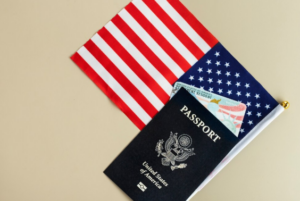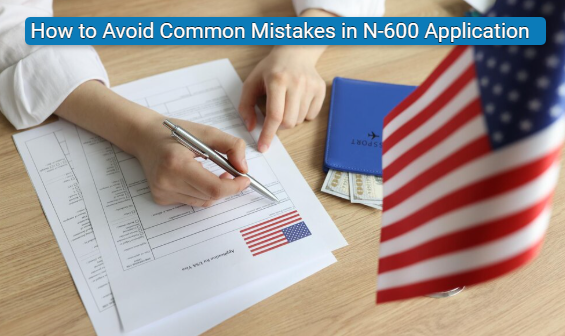How to Avoid Common Mistakes in N-600 Application
Before applying the application many applicants ask other people who are doing what you’re doing right now: trying to figure out how to properly file Form N-600 Application for Certificate of Citizenship.
Some are parents filing for their children. Others are adults who only recently learned they were citizens all along.
Let’s get one thing straight: You’re not alone in feeling that way. Filing for your USCIS Certificate of Citizenship is personal, emotional, and honest. A little intimidating.
We’ve helped so many people through it, and today, we’re sharing the most common mistakes we see with N-600 applications—along with what you can do to avoid them.
Mistake #1: Filing the Wrong Form

We’ve seen this more than once. Someone wants to apply for proof of citizenship and accidentally files Form N-400 (naturalization) or Form N-565 (replacement document).
Here’s how to keep it straight:
- Form N-600 is for people who are already citizens through their parents and want proof.
- N-400 is for people who are not yet citizens and want to become one through naturalization.
- N-565 is for people who need to replace a lost certificate.
- N-600K is for people who don’t have green cards and live abroad
If you’re trying to apply for a certificate of citizenship based on your parents’ status, N-600 is the right one. That’s the certificate of citizenship form you need.
Mistake #2: Assuming You Qualify Without Checking
Here’s a tough truth: not everyone qualifies to use “Form N-600”.
We’ve seen people spend hours filling out the form—only to realize later they didn’t meet the basic requirements. That hurts. It wastes time, money, and energy.
Here’s a simplified version of who qualifies:
- You were born outside the U.S.
- At least one parent was a U.S. citizen at the time you were born (or became one before you turned 18)
- You were a green card holder under 18 and living in the legal and physical custody of that citizen’s parent
If any of those don’t apply—or can’t be proven with documents—your application for a citizenship certificate may be denied.
So before you apply, really ask: Can I clearly show how I meet each of these requirements?
If you’re not sure, talk to someone before filing.
Mistake #3: Sending in the Wrong (or Incomplete) Documents
Let me say this clearly: what you send with the application matters just as much as the form itself.
We’ve had clients who filled everything out correctly… but then sent in a birth certificate that didn’t match their parents’ names, failed to include custody paperwork, or left out proof of the parents’ U.S. citizenship.
It’s frustrating, and it causes delays or rejections.
For most citizenship certificate applications, you’ll need:
- Your birth certificate
- Your green card or permanent resident record
- Your parents’ proof of U.S. citizenship (birth certificate, passport, or naturalization certificate)
- Marriage certificate (if your parents were married)
- Divorce/custody documents (if they were not)
- Adoption papers (if applicable)
- Certified English translations (if anything is in another language)
- Evidence that your US Citizen parent had custody over you
If there’s even a small inconsistency, like a name spelled differently on two documents, USCIS may pause your application or ask for more proof. They won’t guess or make assumptions. They need it to be clear.
Mistake #4: Forgetting the Filing Fee—or Paying the Wrong Amount

The current certificate of citizenship fee is $1,385.
We’ve seen people pay the wrong amount, use a personal check from the wrong name, or forget to include payment entirely.
That’s an automatic rejection. No exceptions.
Also, if you’re requesting a fee waiver (Form I-912), you must submit solid documentation. USCIS doesn’t approve waivers based on explanation alone. They need to see actual evidence of low income, public benefits, or financial hardship.
Double-check this step. It seems simple, but it’s one of the most common issues we see.
Mistake #5: Leaving Blank Spaces or Guessing on Dates
You’d be surprised how many applications get delayed because of blank fields or guessed dates.
USCIS checks everything. If the timeline doesn’t make sense or if things don’t match up with what they already have on file, they’ll send you a Request for Evidence, and that adds months to your timeline.
We get it—sometimes people don’t remember the exact date their parent became a citizen, or when they received their green card. But guessing? That can hurt your case.
If you don’t know a date, take time to find the record. Look for certificates, old mail from USCIS, or even FOIA requests if needed. Don’t guess.
Mistake #6: Thinking a Passport Is “Good Enough”

We’ve heard this a lot:
“I already have a U.S. passport. Why do I need a certificate?”
Short answer: Sometimes, you don’t. But the certificate of U.S. citizenship offers something that even a passport doesn’t—permanent proof.
A passport can expire. It can be questioned. But a USCIS certificate of citizenship holds weight in courts, schools, government agencies, and even immigration cases.
We’ve helped people who were denied federal benefits or had immigration trouble because they couldn’t provide this one piece of documentation. If you’re eligible, it’s worth having.
Mistake #7: Not Understanding the Purpose of the Certificate
Some applicants file “Form N-600,” thinking it’s needed to become a citizen. But if you’re not already a citizen, this isn’t your form.
This form is not a pathway to citizenship—it’s documentation that you are already a citizen based on specific laws.
If you’re not sure of your status, or if your child is adopted and born abroad, or if you have a complicated custody history, don’t just assume. Reach out to someone who understands immigration law before filing.
Mistake #8: Expecting a Quick Turnaround
The average n600 processing time is 8 to 14 months, sometimes more.
We’ve had clients who called us two weeks after applying, nervous because they hadn’t heard anything. That’s completely normal.
Once USCIS receives your N-600 application for a certificate of citizenship, they’ll send a receipt notice. After that, it’s mostly waiting.
- A Request for Evidence
- A biometrics appointment (though this is rare)
- An interview (also rare unless the case is complex)
Then, if everything is accepted, you’ll receive your United States citizenship certificate by mail.
It takes time. But it’s worth it.
Mistake #9: Thinking You Have to Do It Alone

Listen, we get it.
You’re trying to avoid spending money. You’re smart. You’ve filled out forms before. You don’t want to bother anyone.
But here’s the reality: mistakes on this form can cause months of delay, stress, and even denials. We’ve seen people try three or four times on their own before reaching out—and by then, they’re exhausted and discouraged.
You don’t have to go through this alone.
Final Thoughts
The Form N-600 certificate of citizenship isn’t just another piece of government paperwork. It’s confirmation of who you are and what you’re entitled to as a U.S. citizen.
It’s peace of mind for you and your family. It’s the protection of your rights. It’s closure to a process that, for many, has been sitting unfinished for years.
We wrote this guide to help you get it right the first time—because we’ve seen how frustrating it is when people don’t.
Disclaimer or This Article
DISCLAIMER: This article offers general legal information, not legal advice. Do not rely upon this information without seeking legal counsel. If you need legal advice, you may contact us directly to speak with an attorney. We disclaim all liability with respect to actions taken based on any information presented. Every case is different, and outcomes will vary depending on the unique facts and legal issues of your case.
Need Help Filing Your N-600?
At Passage Immigration Law, we help everyday people avoid these mistakes and get approved without the stress and uncertainty.
Don’t leave your citizenship status open to questions. Book your consultation and start your application today.







